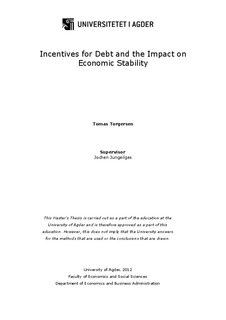| dc.contributor.author | Torgersen, Tomas | |
| dc.date.accessioned | 2012-11-28T12:55:28Z | |
| dc.date.available | 2012-11-28T12:55:28Z | |
| dc.date.issued | 2012 | |
| dc.identifier.uri | http://hdl.handle.net/11250/135849 | |
| dc.description | Masteroppgave i økonomi og administrasjon - Universitetet i Agder 2012 | no_NO |
| dc.description.abstract | The global financial crisis came as a surprise for many economists, governments and populations
around the world. Most economists relied on models of how the economy functions which did not
have the capability to produce or predict breakdowns and crises, because long term stability was
taken for granted and short term deviations were expected to largely resolve themselves by the
normal functioning of free markets. However, other economists have developed theories and
models which predict that excessive economic fluctuations with the potential for breakdowns can
occur. This thesis describes and contrasts two of these theories and their associated models; the
Financial Instability Hypothesis developed by Hyman Minsky, and later modeled by Steve Keen,
and the Leverage Cycle developed by John Geanakoplos. What becomes evident from their
analyses is that conditions in financial markets can have a significant impact on the real economy.
On this background it is argued that individuals, firms and nations under certain conditions are
intrinsically motivated to incur a level of debt, which is sustainable under the tranquil economic
conditions that prevailed when it was undertaken, but leaves them vulnerable and sensitive to
unexpected negative shocks. | no_NO |
| dc.language.iso | eng | no_NO |
| dc.publisher | Universitetet i Agder ; University of Agder | no_NO |
| dc.subject.classification | BE 501 | |
| dc.title | Incentives for debt and the impact on economic stability | no_NO |
| dc.type | Master thesis | no_NO |
| dc.subject.nsi | VDP::Social science: 200::Economics: 210::Economics: 212 | no_NO |
| dc.source.pagenumber | 71 s. | no_NO |
